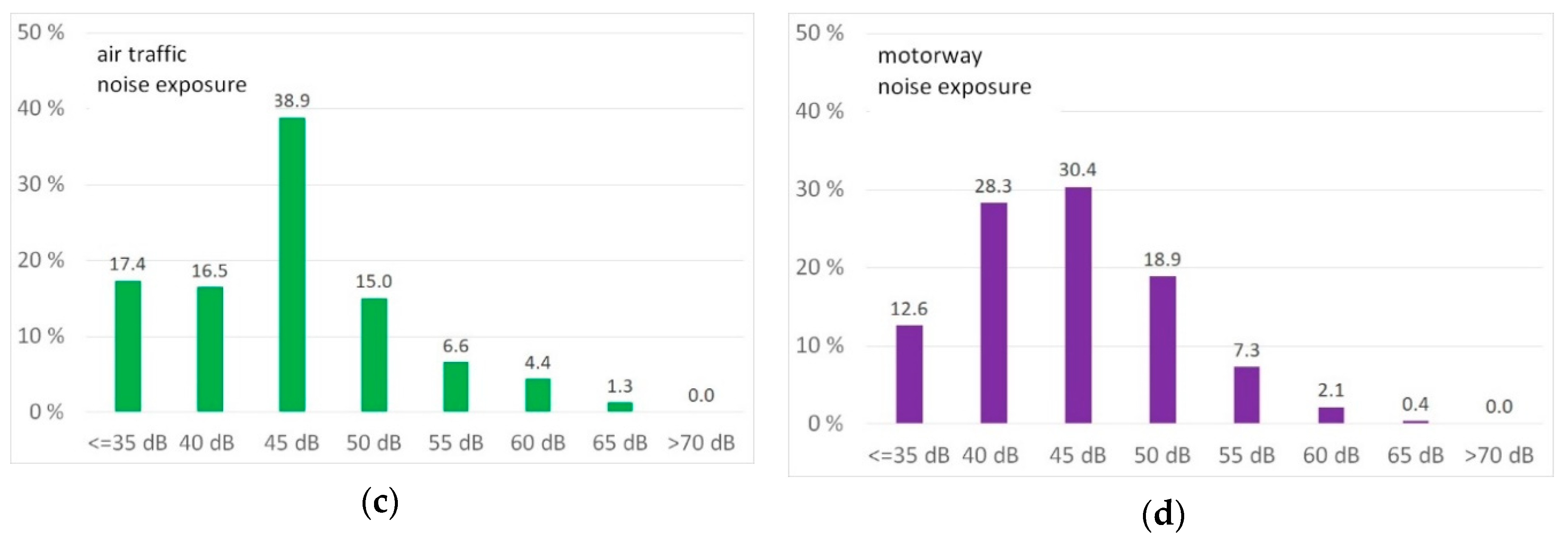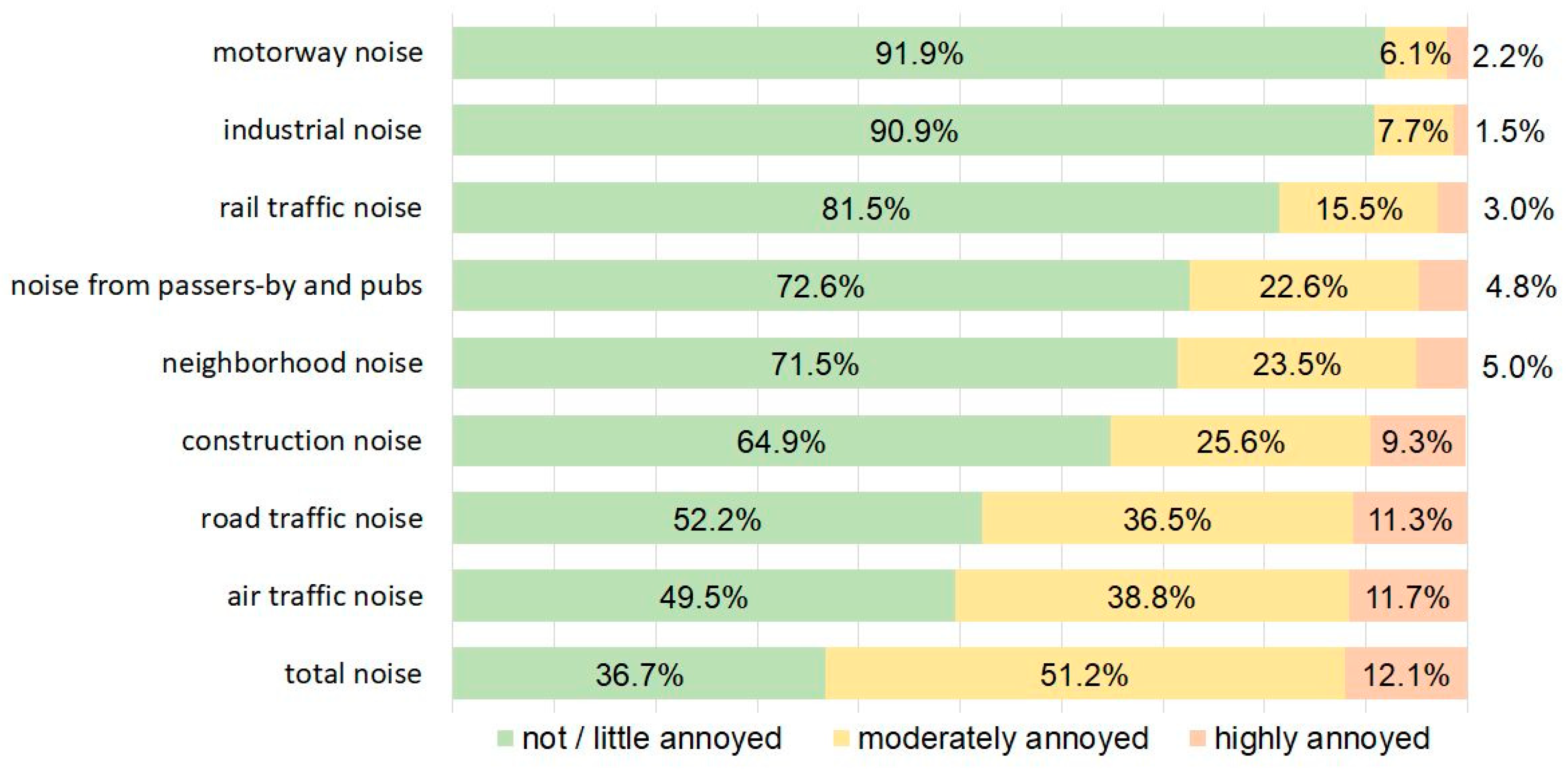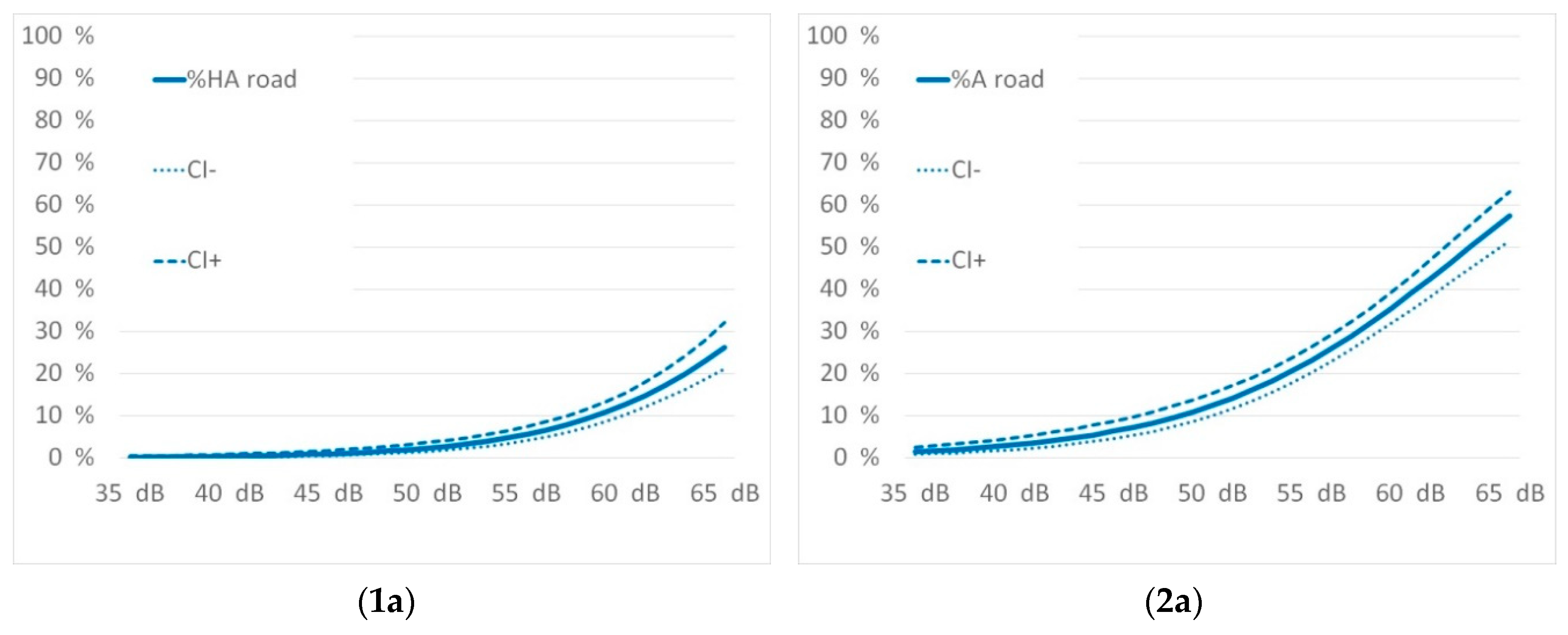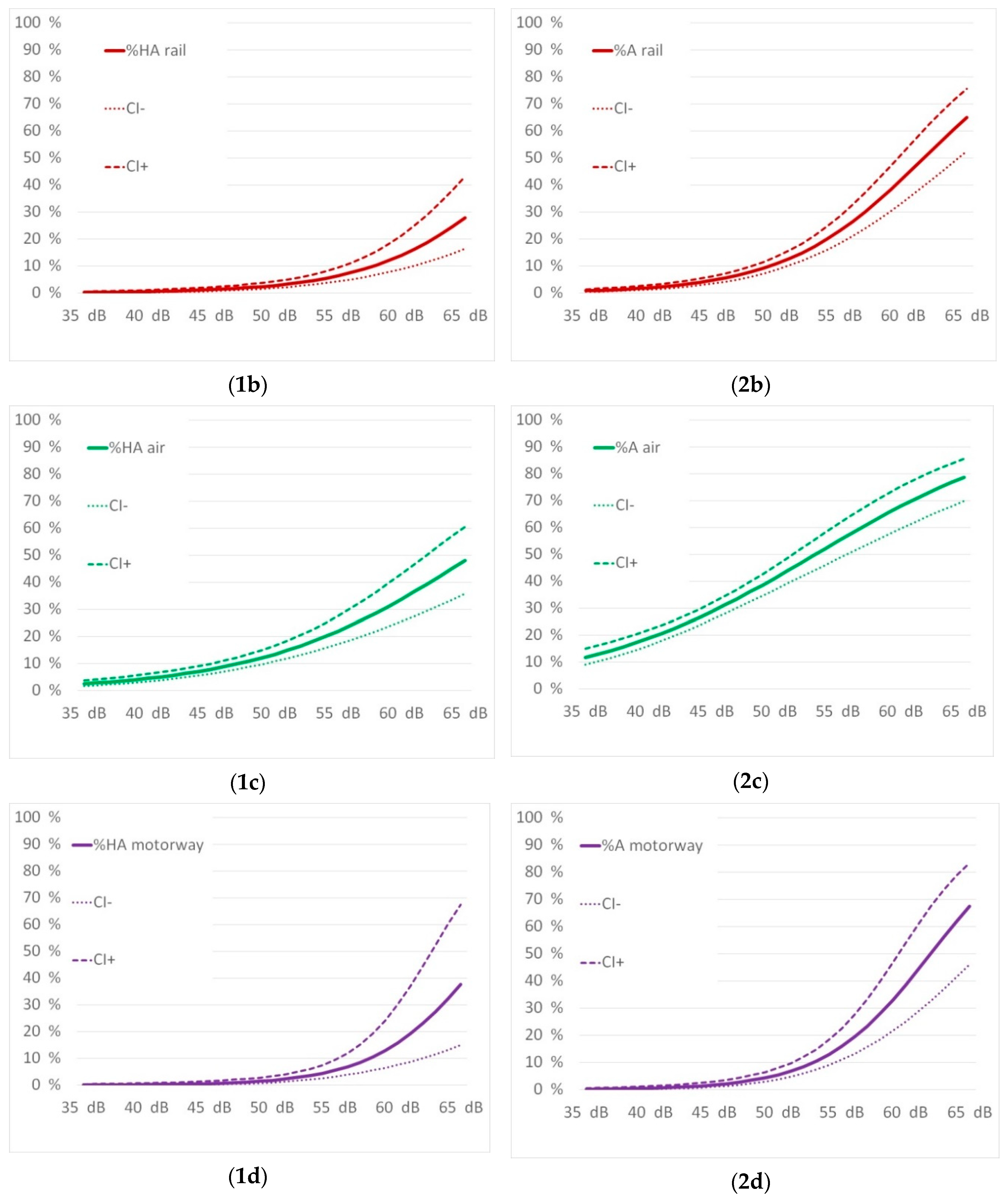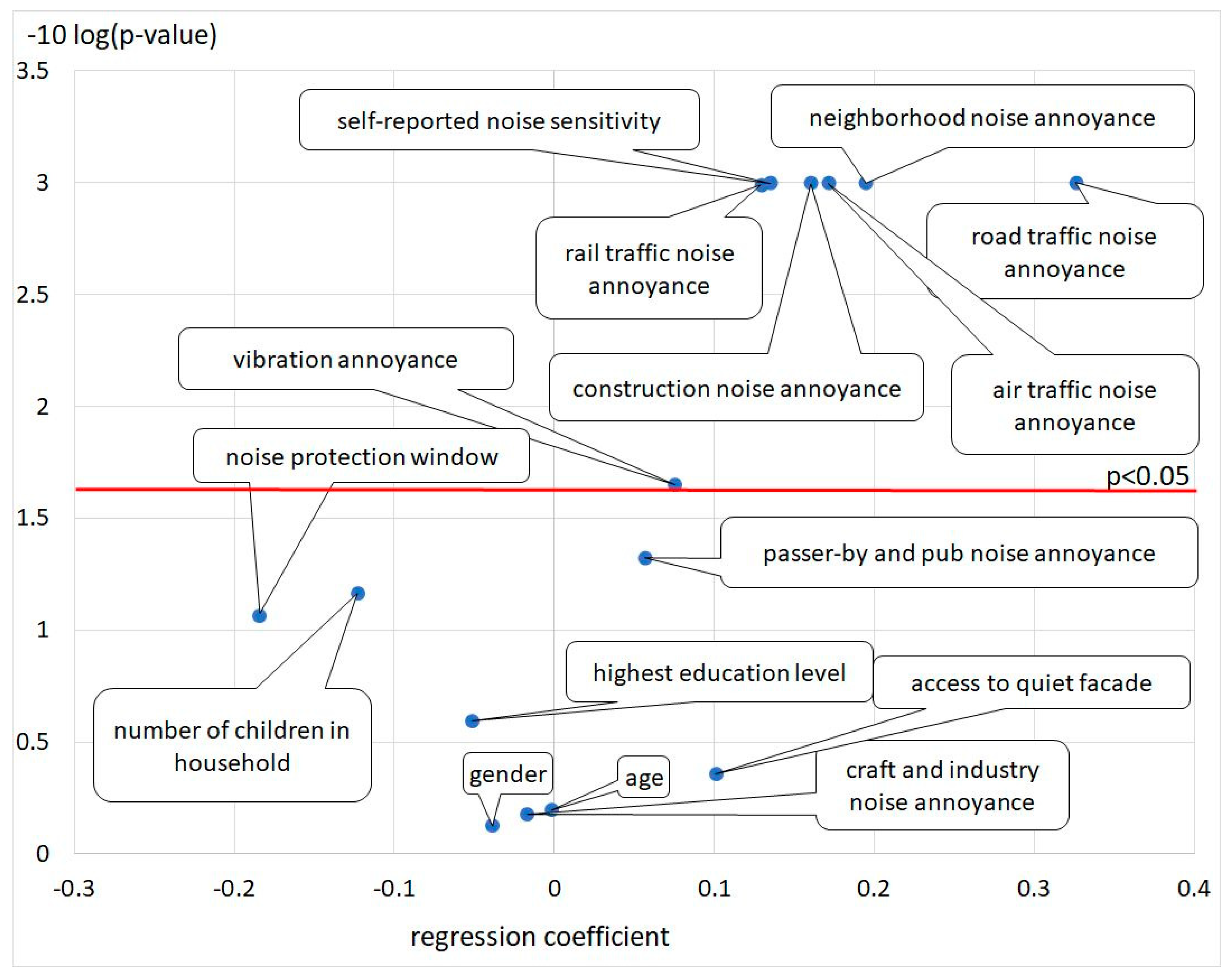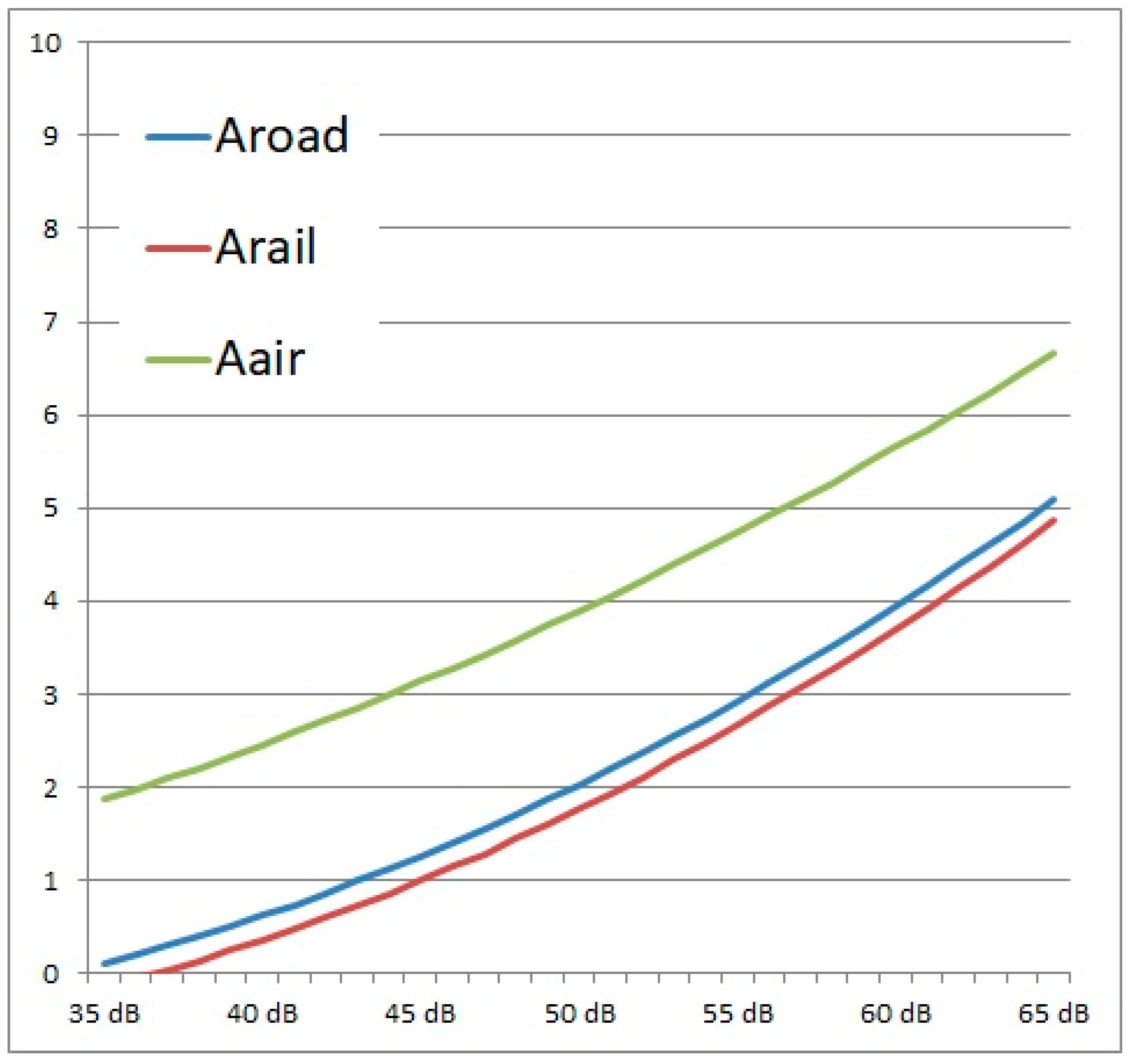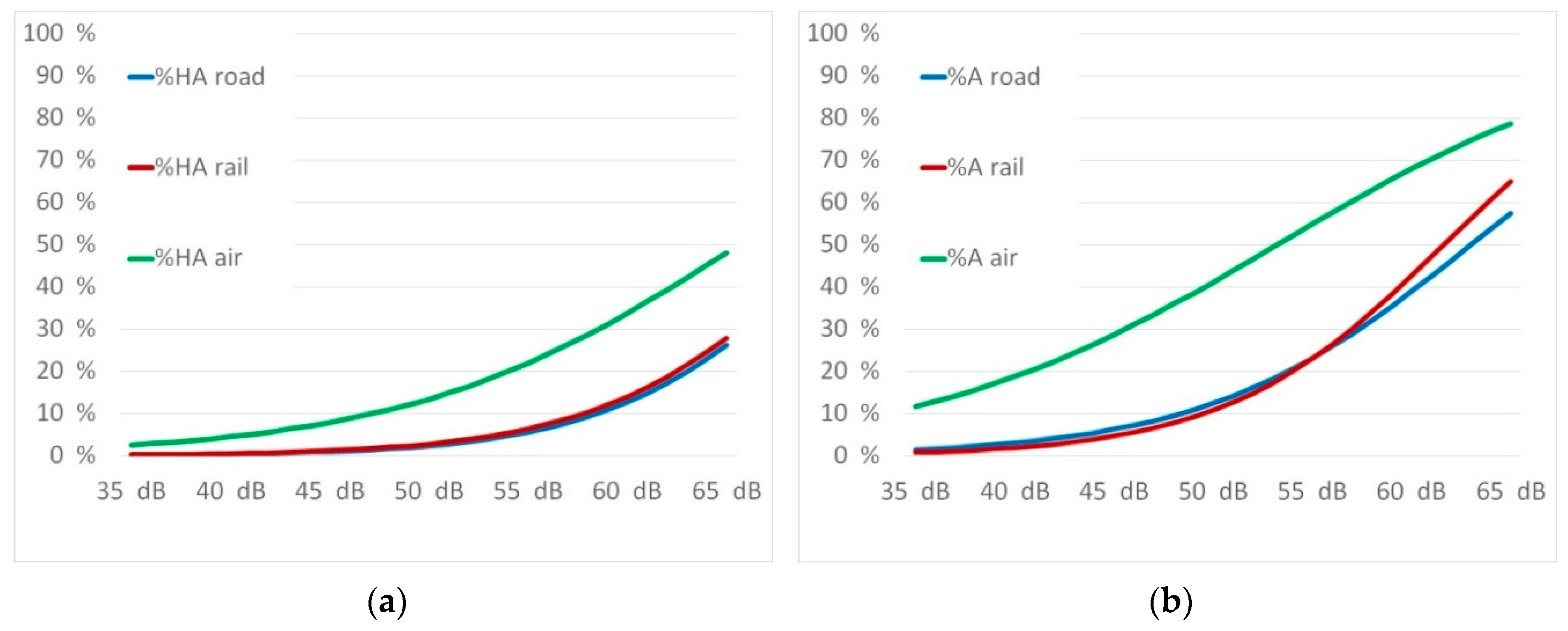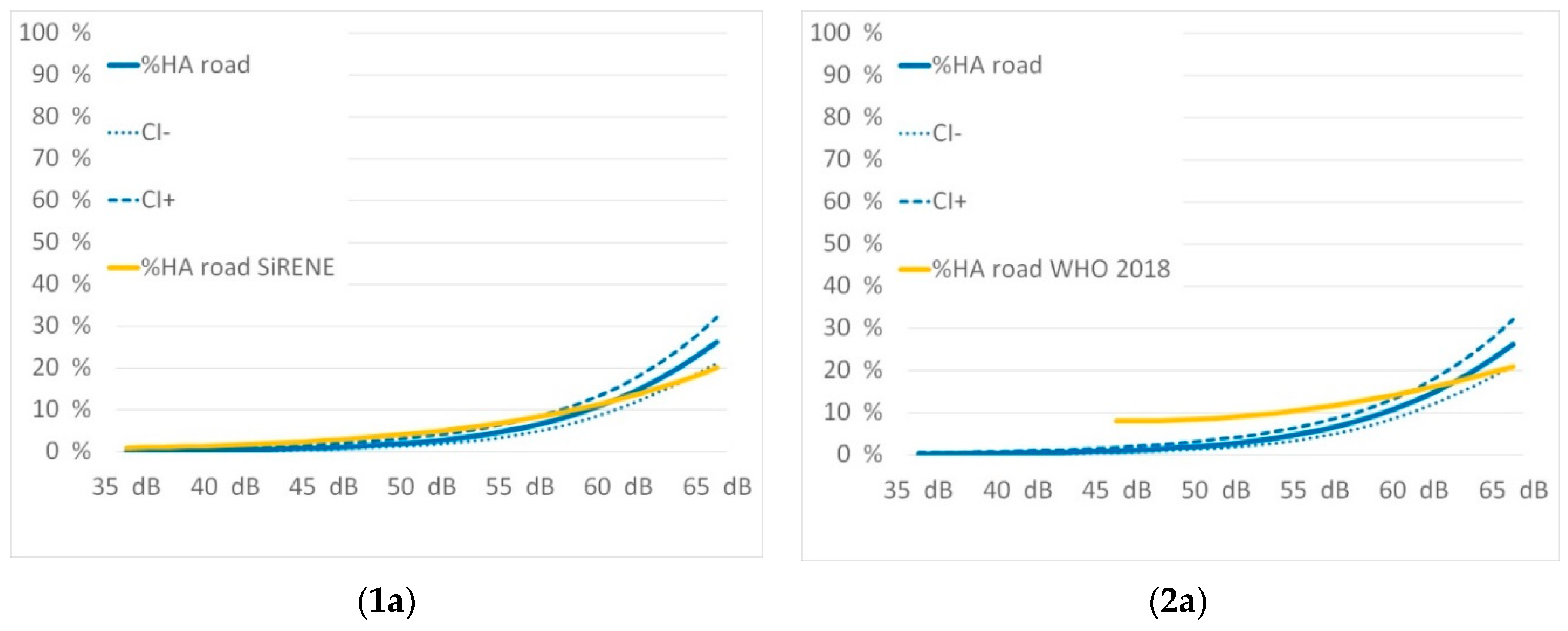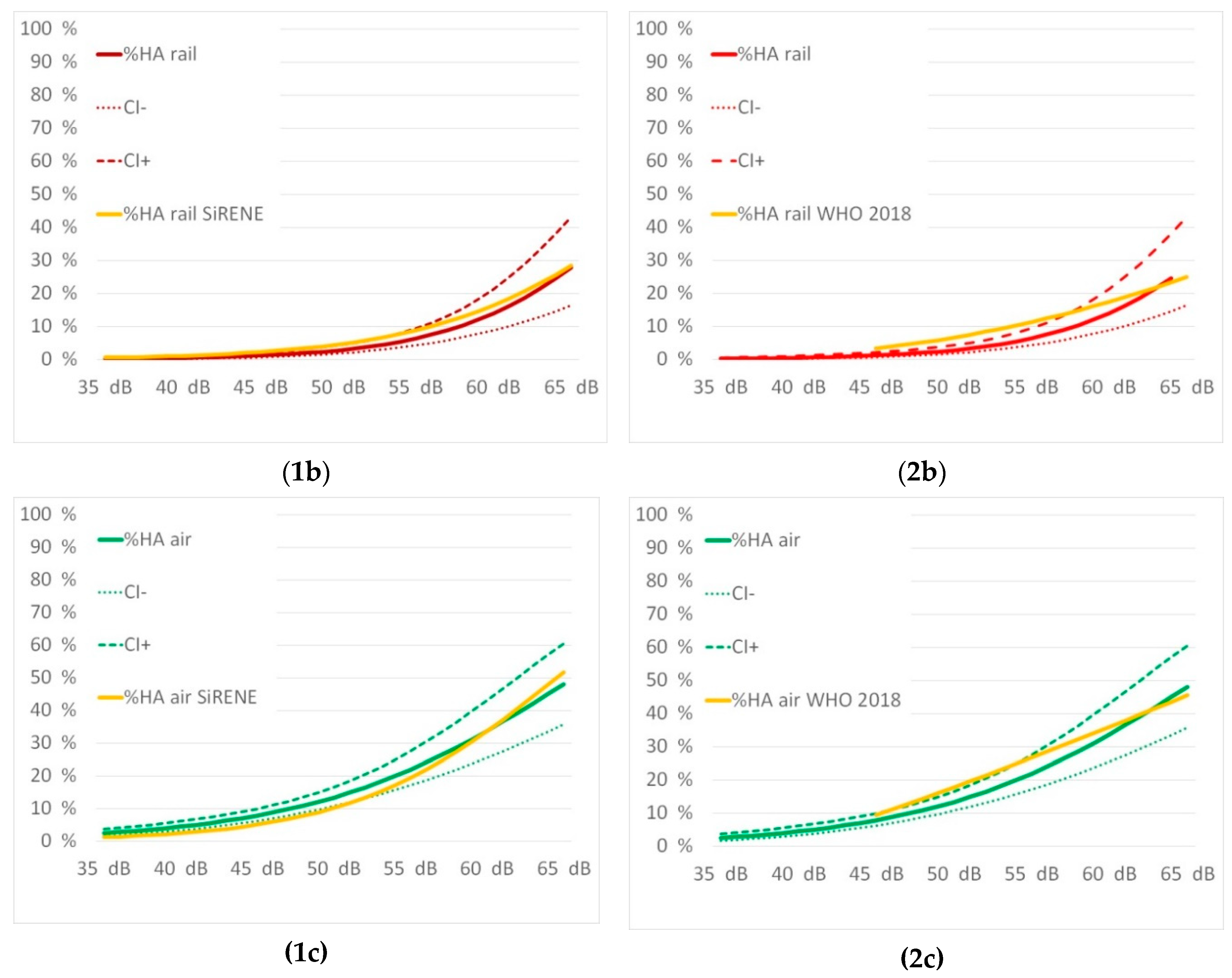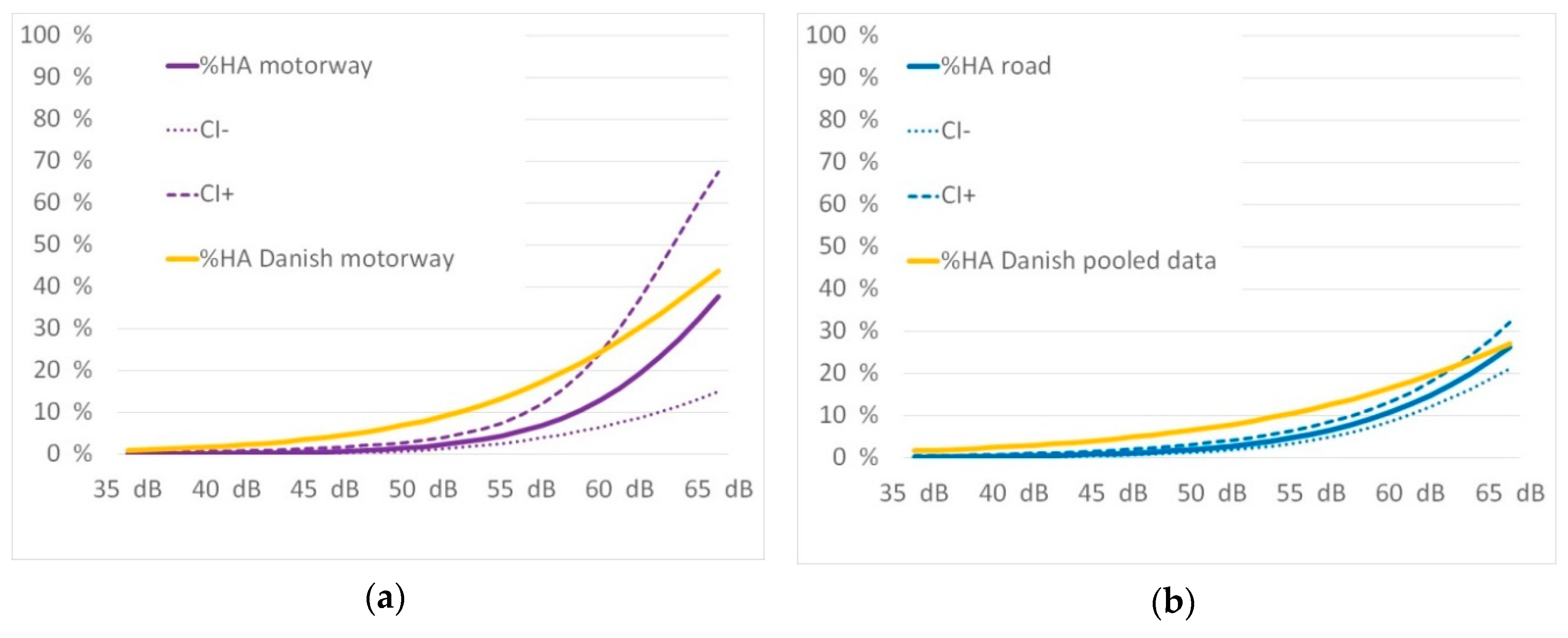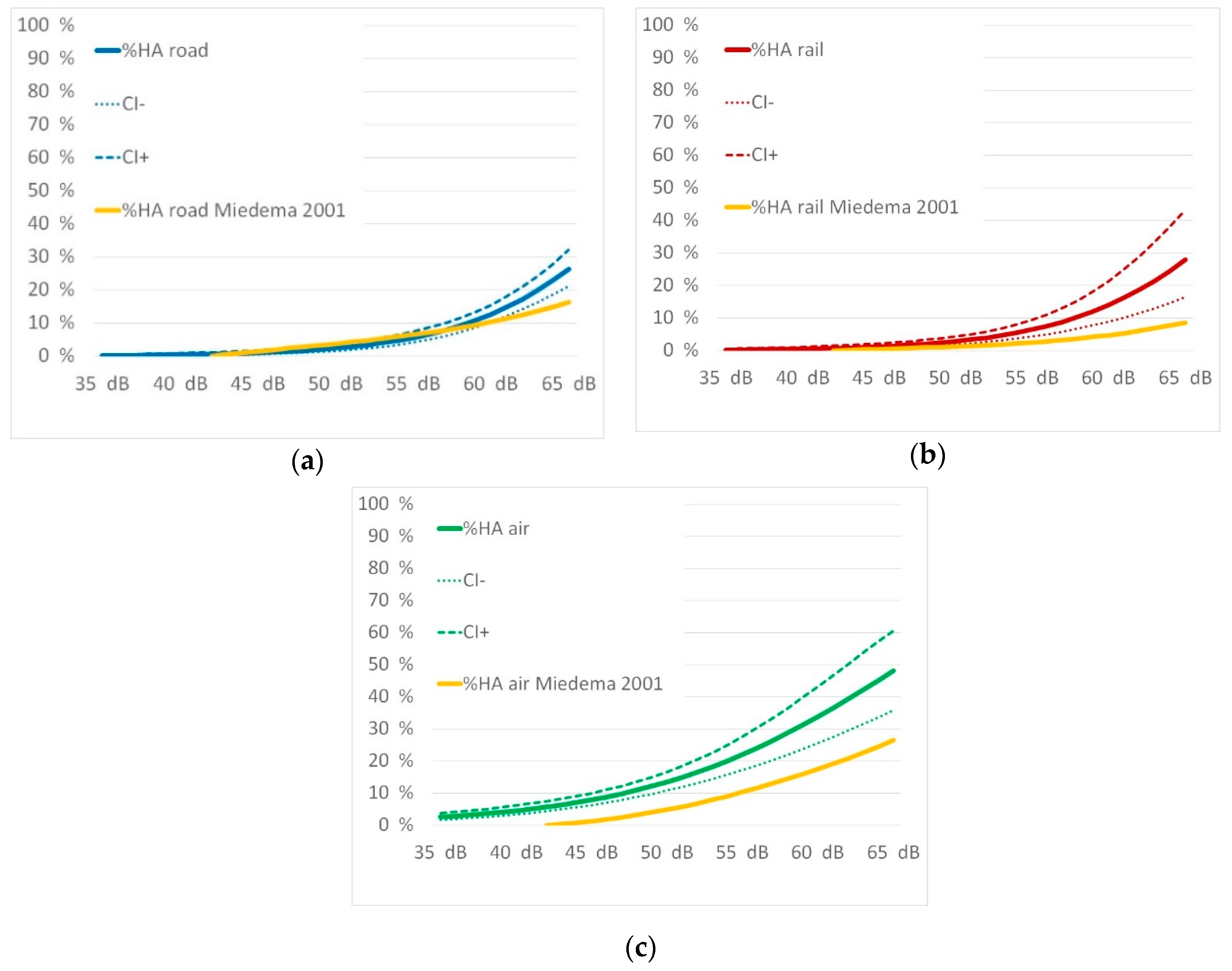1. Introduction
Noise pollution represents a major health problem in modern society [
1] leading to multiple adverse health effects if not properly monitored and assessed. Among them: sleep disorders [
2], learning impairment [
3,
4,
5], ischemic heart disease [
6,
7], and especially annoyance reactions [
8,
9,
10,
11,
12]. In order to attenuate these effects, studies and mitigating measures such as action plans [
13] have been implemented worldwide in the last decades for the main transportation sources of noise affecting modern human lifestyle. A quantification of healthy life years lost in Europe through these health effects was estimated by WHO in 2011 [
14]. For each outcome, based on exposure–response relationships, exposure distributions, background prevalence of disease and disability weights, the burden of disease in terms of disability-adjusted life-years (DALYs) can be calculated. Applying conservative assumptions to the calculation methods the WHO estimates DALYs lost from environmental noise by 61,000 years for ischemic heart disease, 45,000 years for cognitive impairment of children, 903,000 years for sleep disturbances, 22,000 years for tinnitus, and 654,000 years for annoyance in the European Union Member States and other western European countries.
Noise has been creating more and more challenges for decision-makers, especially in alpine urban areas. The aim of the pilot project “Gesamtlärmbetrachtung Innsbruck” (Total Noise Investigation Innsbruck), Ref. [
15] was to create a representative, comprehensive dataset for assessing the overall noise burden and annoyance for the city population of Innsbruck for the first time and additional support data to create an overall noise assessment model. Overall noise assessment is the consideration of the cumulative effects of sound from different sources. This term is mainly used in the assessment of noise from traffic sources. In effect, differing combinations of road, rail, and aircraft noise are commonly shaping the soundscape of our living surroundings.
Many studies describe relationships between exposure and effects of the most important single noise sources like road traffic [
10,
16], railway traffic [
17,
18], airport and air traffic [
19,
20,
21], and harbors [
22,
23]. In a broader sense, total noise is the sum of the effects of all sound, be it from traffic, industrial plants, passerby, neighboring, construction sites, or even natural sounds such as those caused by wind or water. In this paper, the term is used only for the combination of traffic noise sources. On the one hand, an overall noise assessment of affected citizens is repeatedly demanded; on the other hand, the involved experts criticize the lack of evidence from field studies. According to a decision of the Federal Administrative Court it seems clear that a total noise assessment does not correspond to the state of the art in health sciences and other relevant sciences [
24] in the Austrian jurisdiction.
A recent publication from R. Guski and colleagues on noise annoyance with a meta-analysis of 57 studies included five studies on noise source combinations published in four papers. All studies include road traffic noise; two of the studies combine road and railway noise, two combine road and aircraft noise, and one combines road and industrial noise. The total dataset includes 1949 participants. After performing the analyses, however, it became apparent that it was unwise to integrate different noise source combinations into one single analysis. Unfortunately, there were not enough studies available even for the meta-analysis of combinations of two sources. With respect to the weights given for the separate noise levels in future combination studies, the results point to the importance of a dominant source model where annoyance is assessed according to the strongest component [
25] in terms of annoyance and underline the existing need for further research on total noise assessment for all three traffic noise sources: road, rail and air traffic [
26].
The 2015 NORAH study [
27], which was conducted in the vicinity of Frankfurt Airport, dealt with the combined effect of aircraft and rail traffic noise, as well as aircraft and road traffic noise, and showed a preference for a nuisance model for the unweighted 24-h continuous sound level according to the loudest source (dominant-source model) [
28]. The peculiarity of this study also lies in the significantly different exposure-effect relationship of aircraft noise compared to the other two sources, road and rail traffic. According to the authors, this was based on the special political significance of Frankfurt Airport at the time of the survey. The authors stated that the transferability of their results is therefore limited.
Several other recent studies have dealt with the combined effect of two traffic noise sources. In a French study with a total number of 1010 of respondents in 8 cities, models for the combined annoyance from road and rail traffic noise were tested [
29]. In these studies the Miedema annoyance equivalents model [
30] for all three sources was applied for the highly annoyed, annoyed, and (at least) a little annoyed groups according to annoyance reactions identified and based on interview surveys. The determinations of the exposures were grouped. A thesis-testing was not carried out in this study, but the survey results corresponded with the theoretical ones [
31].
In Montreal, a study was conducted into the common effects of traffic noise sources, namely road, rail and air traffic noise, as well as other noise sources [
32]. However, the study design and results are not easily transferable as the authors themselves already emphasized that the reactions of their respondents were very different from those in Europe. The determination of noise effects could only be grouped or merely estimated. A total noise model describing the common effect based on noise levels or noise indicators was not included.
Specifically, there is a research gap consisting of the lack of field studies in which the overall noise effects regarding annoyance as a result of the effects of road, rail and aircraft noise are directly and for this purpose investigated. In addition, there is a need for more evidence for the basic assumption of the annoyance equivalents model with respect to the independence of variables [
30].
The research questions were therefore formulated as follows:
- (1)
Is there a relevant influence of road traffic noise on the annoyance response to rail traffic noise?
- (2)
Is there a relevant influence of road traffic noise on the annoyance response to air traffic noise?
- (3)
Does the influence of road traffic noise in combination with rail traffic noise and air traffic noise lead to an increased overall noise annoyance (total noise annoyance)?
An overall sleep disturbance model due to different noise sources is not in the content of this paper.
4. Discussion
4.1. Covariates in the Model
Purposeful selection of covariates [
48] in the logistic regression was helpful in identifying variables that, by themselves, were not significantly related to the outcome but made an important contribution in the presence of other variables. The univariate correlations for total noise annoyance, as given in
Table 5, showed different results for total noise annoyance for highly annoyed and annoyed. While the dichotomized results for highly annoyed showed significant influence for the noise index for road and air, but not for rail traffic noise, the results for annoyed showed significance for all three noise sources. The reason could be the small number of highly annoyed from rail traffic noise. The significant results for annoyed participants influenced by all three traffic noise sources is an indicator that an annoyance equivalents model is appropriate to describe total noise annoyance by multiple sources. The typical epidemiological covariates, such as age (age squared) and gender, were not significant. In both categories, highly annoyed and annoyed, the self-reported estimation of noise sensitivity, access to a quiet facade and installation of special noise insulation (noise protection windows) were significant. While the self-reported noise sensitivity but also the access to a quiet facade had an increasing effect on noise annoyance, the sponsored installation of noise protection windows decreased the noise annoyance. The influence of self-reported health status, education, the fact of owning a residence and the type of dwelling were not significant. Only in the category annoyance could a significant correlation between numbers of children in the household be shown.
As shown in
Table 8, all traffic noise sources positively and significantly increased the overall noise annoyance score. This was also the case for all other annoyances caused by not modelled sources, except annoyance from craft and industry noise and noise caused by passers-by and pubs. This can be explained by the special local character of these sources. Another explanation could be the character of industrial sounds which contain tonal or impulsive components or are dominated by low frequencies. Noise from passengers and pubs, as well from the neighborhood characterized by informative sound, also significantly contribute to the total noise annoyance score. Access to a quiet facade and noise protection windows installed within the last 10 years were not significant variables. Clearly, age, gender and educational level were not significant.
As shown in
Table 6, no significant influence of road traffic background noise was found according to the annoyance of rail and air traffic noise. In both categories of highly annoyed and annoyed, the self-reported noise sensitivity had a significant influence.
The binary logistic regression with the included interaction terms did not show usable results. Except for the subjectively reported noise sensitivity with a strengthening effect on annoyance, there were no significant contributions to either the annoyed category or the highly annoyed category. This was found at the level of the individual sources with the interaction terms for all source combinations. One reason may be an oversaturated model. In accordance to this finding, the annoyance equivalents model was set up not by the dichotomous annoyance reaction annoyed and highly annoyed, but by the annoyance response of the 11-point scale itself. A linear regression of all contributing single annoyance reactions showed significant effects for each source, except noise from craft and industry, passers-by, and pubs. This finding was used as the basis for the total annoyance model for traffic noise.
4.2. Comparison of the Exposure Response Relations with Other Study Results
A comparison overview of the exposure response curves for the percentage of annoyed and highly annoyed for all three traffic noise sources is given in
Figure 6.
The curves of both highly annoyed as well as annoyed show a similar picture. While annoyance from road and rail traffic is approximately the same, air traffic causes significantly higher reactions. This is completely in line with the results of recent studies as discussed below.
The exposure response relations were assessed versus the recently published results of the SiRENE study from Switzerland [
12] and the WHO recommended curves adapted from Guski´s and colleagues metaanalysis [
26] as published in the 2018 guidelines [
50]. Both studies considered recent data and had similar methods describing the exposure.
Figure 7 compares their results with the ones from Innsbruck:
Figure 6 shows that there is a rather good fit of the exposure-response curves for the percentage highly annoyed (%HA) for each of the traffic noise sources. The SiRENE curves are within the confidence intervals of the Innsbruck curves in almost the entire level range. Thus, the slope of road traffic noise annoyance in Innsbruck is steeper indicating a percentage of highly annoyed of 26% at 65 dB L
den while SiRENE indicates 20%. This could be a result of the different settings. While SiRENE has pooled data from urban and rural areas, the Innsbruck study relies only on an urban data set. The rail and air traffic noise response curves fit very well together.
The WHO-curves do not fit our data as well as the data of SiRENE do. The slopes of the WHO curves are obviously flatter, and this causes an important effect: The WHO derives its recommendations on thresholds for adverse health effects from an absolute risk for highly annoyed of 10%. This occurs for road traffic noise at L
den of 53 dB according to the WHO curves, but not before 59 dB according to the Innsbruck curves. The curves obtained provide the opportunity to set appropriate thresholds or limits and to take greater account of local specificities. The results are also in contradiction to former studies in the alpine space [
11] where much stronger noise annoyance reactions versus road and rail traffic noise were observed. It seems that the recent results, which are in line with the SiRENE results, bring new valid information for alpine space too.
The Danish road study [
10] also elaborated exposure response relations according to annoyance and different road types. Motorway noise was compared to urban road noise. The authors were contacted to share their parameters for the pooled data for motorway and urban roads. The exposure response relations were assessed versus the results of the Danish road study for the motorway and the urban road situations. This is shown in
Figure 8 as follows.
The curves from the Danish road study are a better fit to the WHO [
50] curves. The percentage of highly annoyed in Innsbruck is much lower as shown in the lower exposure levels. At higher levels of approximately 65 dB the curves meet. In both situations it is shown that motorway noise causes a higher percentage of annoyance than the pooled data.
The European Commission recommended the use of the exposure- response curves of Miedema and Oudshoorn [
8] to be used for noise assessments and the formulation of limit values in the member states of the EC.
Figure 9 shows exposure–response curves from Innsbruck versus the Miedema curves [
8].
The comparisons of rail and air traffic noise show that Miedema´s curves [
8] are underestimating the annoyance effects in Innsbruck. The comparison of road traffic noise evidences a point of intersection between 58 to 59 dB L
den. This is corresponding to a percentage of 10% highly annoyed. Up to these noise levels the former derivation for limiting values for road traffic noise is still appropriate, for rail and air traffic noise an amendment seems to be necessary.
4.3. Total Annoyance Assessment Model for Traffic Noise
A Total Annoyance Assessment Model for legal application must be suitable for all types of source-combinations but also for single sources. The target is to define a single value that can be checked against one common limiting value. This limiting value should express the same probability of annoyance independently of the source or source-combination. This means that if only one source has a relevant impact on a receiver the annoyance should be appropriately described by the used noise index. As shown in
Figure 5 there is a difference of 2 points in the 11-point annoyance scale between air traffic noise and road traffic noise respectively rail traffic noise. Obviously, a singular physically model where the noise levels are summed up logarithmically does not meet the requirements for every single source assessment. As the physical noise level gathered for aircraft noise would lead to the same annoyance score than for the two other sources the approach of physical summation was not further investigated. There are different approaches and findings in the published literature regarding the assessment of which model best fits to the annoyance response to noise impact of multiple sources. While Miedema introduced the annoyance equivalents model [
30], other researchers [
28,
29] had better fits for the dominant source model. In a French study [
29] the combined effect analyses started at 55 dB L
den because this was the lowest exposition value for rail traffic. In Innsbruck we rated inhabitants with such an exposition already as strongly affected. Within the overlap between 55 and 65 dB the results are comparable. As a result, Gille and colleagues stated that in general perceptual models facilitate a better calculation of total annoyance than psychophysical models. This result is approved by the study in Innsbruck.
Wothge and colleagues found a plausible reason for this by explaining the response on air traffic noise was so high due to political circumstances. Their study took place in the context of an environmental impact assessment for a major change in Frankfurt Airport. Between 2011 and 2013, residents around Frankfurt airport were surveyed three times in a panel-study. The main focus of the panel-study was to investigate the impact of aircraft noise on the noise annoyance and quality of life of residents before (2011) and after (2012, 2013) the opening of a new landing runway at Frankfurt airport (called “North West”) in October 2011.
Our study in Innsbruck had no such background for any of the noise sources. There were no running or planned projects in any of the modes of transport which could have had an influence on the judgment of the 1031 participants. In addition, the clusters were selected by the three zones of highly-, medium-, and little-affected areas for the three sources. It seems that this method produces valid results. Spearman´s Rho for the annoyance equivalents model was predicted with 0.298 (
p value 0.000 is significant at the 0.01 level 2-tailed). In comparison to this, the dominant source model shows a much lower correlation with 0.112. As was shown, there are more sources than only the traffic noise sources that cause the total annoyance. Construction noise, neighborhood noise and noise from passers-by and pubs in open spaces are the most relevant of them. Therefore, it is understandable, that the correlation is not as high compared to the annoyance reaction to a single noise source. However, with Sperman´s Rho of 0.298, it is still within a well-known range of correlation in noise impact research [
51]. This model can therefore be recommended for useage in overall noise assessment and is especially to be considered in regulatory approval procedures where an overall noise assessment is required.
4.4. Strengths and Limitations
A limiting factor, as with many similar studies, is the determination of the exposure according to the level of the most exposed facade. Thus, the real impact situation is not representative for people who have their living and/or bedrooms towards quiet facades. The study shows the exposure and response situation in an urban area. A transfer of the results into the setting of rural areas should only be performed with care.
One strength of this study was the initial design to evaluate the combined effects of multiple sources. The groups of exposed people to road, rail and air traffic noise and the combinations of it are nearly equally distributed. Another strength is the use of personal interviews as the survey instrument; and the overall response rate of 47.8%, which is to be considered as very high. These facts increase the representativeness and validity of our results.
Other strengths include the rating of the exposure by state-of-the-art sound propagation methods, taking all flight movements, all streets down to access roads, and each train passing by into consideration and the modelling of noise exposure on each building. These were performed prior to the survey. Applying these noise clusters, the participants for the survey were selected. The sound propagation methods are valid in Austria for environmental impact assessment and represent the state-of-the art engineering technology. No accuracy was lost by classification to noise bands.
Due to the high response rate and the stratified selection of 1031 participants, the selection bias is rated to be low.
A limitation of this study is the annual and daily noise conditions at the airport. The main air traffic takes place in wintertime, caused by winter tourism in the State of Tyrol. This circumstance was taken into account by setting the survey period outside the main traffic period. The survey took place in May and June when the winter charter air traffic was finished but was still remembered by the participants. Brink and colleagues [
52] evidenced that questionnaires filled out in autumn were associated with a significantly higher annoyance rating than in springtime. Average annoyance responses in their autumnal assessment exalted by the same amount as a 1.7 dB increase in L
dn. Compared to the difference in the average of winter charter exposure and the yearly average of aircraft noise consisting in an L
den of 1.5 dB this could be compensated in Innsbruck. By choosing the survey season in early summer/late spring a valid mean score could be achieved.
5. Conclusions
In Austria the general approach for rating noise is the assessment of annoyance after the change of actual local conditions. These local conditions are usually described by road traffic noise. The higher the noise level of a road, the higher is the allowable additional level of a specific noise source. As shown in
Section 3.4, no significant influence of road traffic noise on the annoyance to rail and air traffic noise was found. No protective effect by road traffic background noise could be shown for rail and air traffic noise. The recent noise regulations for rail and air traffic noise do not take background noise of road traffic in account. For other noise sources, especially industrial noise, the traditional Austrian legal approach is the assessment of specific noise by background noise. Further research is required to provide evidence on effectiveness of this approach.
An assessment method separating noise source by noise source to arbitrate annoyance is not valid enough. As shown in this study with 1031 participants in Innsbruck each additional noise source causes an increased effect on the total noise annoyance. For overall noise protection, a comprehensive approach is needed. The study evaluated an annoyance equivalents model [
30] based on the elaborated exposure response function in the city of Innsbruck.
A benefit of a total noise assessment is the possibility to combine all known sources by exposure response curves. By adjusting a single source, for which road traffic noise is strongly recommended, all sources and source combinations can be rated by a single assessment method. Threshold values can be set for all single sources using a substitution level which results in the same annoyance score as road traffic noise and combinations of source combined by energetic addition as already introduced for wind turbine noise [
53]. Further noise sources in addition to traffic noise sources need to be investigated.

